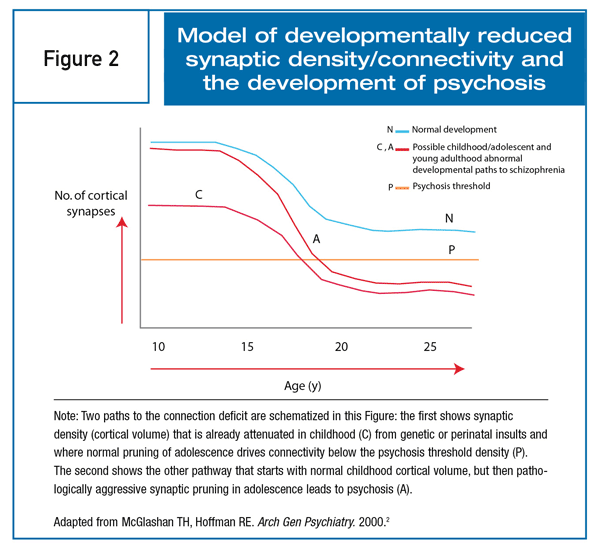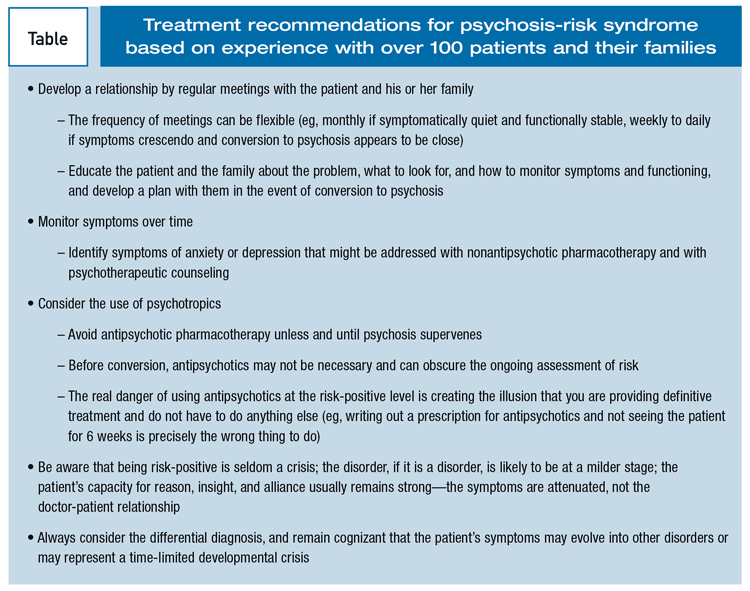Publication
Article
Psychiatric Times
Early Antecedents and Detection of Schizophrenia
Author(s):
Much resistance to disorder status for the psychosis-risk syndrome stems from the fact that only a minority of those given the diagnosis really have the disorder.
Figure 1

Figure 2



Given the often irreversible deconstruction of a life that psychosis can bring to individuals and their families, strategies for early detection and intervention have become a focus of increasing interest. These strategies aim to prevent disorder by identifying, tracking, and treating the clinical antecedents to psychosis. In this article, we review the underlying rationale for this direction, the evidence that prevention of psychosis is possible, what psychosis-risk states look like clinically, what treatment studies show to date, and the risks and benefits of early intervention. We also outline what psychiatrists can do clinically, given what we currently know.
Early stages of psychosis
Figure 1 illustrates the typical emergence of the early stages of psychosis as it unfolds during adolescence/early adulthood. As clinicians, we usually encounter and treat patients well after the first episode, when chronic deficits in functioning are already in place and positive symptoms wax and wane with the vicissitudes of treatment adherence. However, the emphasis needs to shift to the earliest stages of this process and on how antecedent genetic vulnerability and developmental liability are initially expressed as psychopathology during the final major stage of neurodevelopment in adolescence/young adulthood.
As schematized, premorbid normality gives way to declines in school, work, and social functioning. Soon thereafter, psychological symptoms emerge that are precursors to the positive symptoms that later become the basis of a DSM diagnosis of psychosis. At this earliest stage, however, these symptoms are not as prominent or disabling as they are in full-blown psychosis, and typically they are labeled “prodromal” or “psychosis-risk” symptoms and functional deficits.
At some point, these symptoms and deficits become prominent enough to meet standard diagnostic criteria, but medical recognition and treatment usually do not occur until weeks, months, or even years later. This interval is known as the duration of untreated psychosis (DUP), which has become a major target of early intervention strategies.1
The neurobiological processes underlying this emerging clinical picture are more hypothetical. One model is illustrated in Figure 2.2 This model postulates that psychosis is the product of inadequate cortical synaptic connectivity that typically emerges or is “expressed” in the final adolescent/young adult stage of neurodevelopment, when cortical synapses are normally pruned.
Two paths to this connection deficit are schematized in Figure 2. In the first path, synaptic density is already attenuated in childhood from genetic liabilities or perinatal insults such that the normal pruning of adolescence drives connectivity below the psychosis threshold density. The second path starts with normal childhood cortical volume, but then pathologically aggressive synaptic pruning in adolescence leads to psychosis. The details and the mechanisms of this process are not the focus of this article. However, Figure 2 is presented to illustrate the hypothesis that psychosis is a product of aberrant neurodevelopment and that for any intervention to be truly preventive, it must somehow slow down, halt, or reverse this trajectory-a daunting task indeed!
Reducing DUP
Initial efforts toward secondary prevention have focused on the first psychotic episode and reducing the DUP-the period between onset and first treatment. Dozens of studies have demonstrated a robust correlation between delayed first treatment (longer DUP) and poorer outcomes.3,4 However, it was not until the Early Treatment and Intervention in First-Episode Psychosis (TIPS) series of studies over the past 12 years that any effort had been made to actually change the DUP and measure its effect on outcome. The hypothesis is that a shorter DUP in first-episode psychosis would be associated with better outcomes.4
The TIPS study is complex and ongoing, but the core findings are that the DUP can be significantly reduced through educational campaigns about psychosis aimed at practitioners, schools, and the general public.5 In the study, such an effort was engineered in a single Scandinavian health care sector. The outcomes for a 4-year sample of first-episode psychotic patients from this sector were compared with the outcomes for 4-year first-episode samples from 2 control health care sectors that made no effort to reduce the DUP.
The target sector achieved a significantly shorter DUP than the control sectors. Baseline and 1-, 2-, and 5-year outcomes have been significantly better in the experimental sector sample, especially with regard to negative symptoms and functional deficits (the core chronic symptoms of schizophrenia).6-9 All of the study sites in the TIPS series used a standard treatment battery of antipsychotic medication, individual therapy, and family therapy. Therefore, sector outcome differences were most likely related to the different timing of the same treatments, ie, earlier treatment resulted in a genuinely healthier cohort of patients.
We regard this as preliminary but compelling evidence that earlier diagnosis and earlier administration of standard treatments in the course of first-episode psychosis may actually truncate the neurobiological process(es) that generates chronicity (eg, excessive pruning). The result requires replication, but we and our Scandinavian colleagues are excited that the data strongly endorse the validity and preventive potential of early detection and treatment of psychosis.
Moving backward
If treatment earlier in a first episode can improve prognosis, could treatment before onset in the prodromal phase of the disorder actually delay or prevent onset? That question, raised by TIPS, has attracted increasing attention in early-psychosis treatment centers for more than a decade. More recently, the prevention field has been moving further backward, or earlier, in the temporal course of disorder development to the psychosis-risk or the prodromal phase of psychosis.
The study of the preventive potential of pre-onset or psychosis-risk intervention requires a common and reliable diagnosis of a risk syndrome with which to construct samples that we can track and treat and that can be replicated by independent clinical investigators. Yung and McGorry10 created the Comprehensive Assessment of At-Risk Mental States (CAARMS), a structured interview for diagnosing the psychosis-risk syndrome. Our team at Yale developed the Structured Interview for Psychosis-Risk Syndromes (SIPS); this tool is used to rate the severity/frequency of key prodromal symptoms and can be used to determine the presence or absence of several psychosis-risk syndromes. It can also be used to estimate the severity of these symptoms and syndromes, including the boundary of transition from the prodrome to psychosis, called “conversion.”11
The interrater reliability of the SIPS is satisfactory.12 Moreover, the SIPS has proved to be a valid predictor of psychosis insofar as psychosis developed over the next 2.5 years in approximately 33% of a large sample of treatment-seeking persons meeting SIPS criteria.12,13 In essence, approximately 1 of 3 persons who met an SIPS prodromal diagnosis became psychotic, which amounts to a risk for psychosis that is more than 400 times the risk for the average individual. Some of the remaining two-thirds of the sample who met an SIPS prodromal diagnosis and in whom psychosis did not develop remained prodromally symptomatic and eventually met criteria for schizotypal personality disorder; in others, Axis I disorders, such as depression, developed; and in many, prodromal symptoms remitted with time without sequelae (J. Addington et al, unpublished data, 2010).
Despite this heterogeneity of outcomes, some of which are benign, it is important to note that persons who come to our psychosis-risk research centers are almost always treatment-seeking adults and young adults. Most are referred to us by practitioners in the area who are familiar with our clinic and with what kinds of patients we are looking for. The patients we evaluate and serve are definitely not from the ranks of the “worried well.” By and large they are disturbed, dysfunctional, and struggling with new, strange, and puzzling symptoms, and their families are baffled and very worried.
Treatment research in psychosis risk has just begun, and initial findings show promise. Combined antipsychotic (risperidone) and individual psychotherapy, antipsychotic therapy alone (olanzapine), and psychotherapy (cognitive-behavioral therapy) alone all show that onset of psychosis in prodromal samples can be delayed, but often with substantial adverse effects (eg, weight gain with olanzapine).14-16 Most recently, a randomized trial of v-3 fatty acids delayed onset of psychosis with virtually no adverse effects.17 In this study, the risk to benefit ratio is remarkably good, and if the results can be replicated, they should essentially eliminate concerns about untoward adverse effects in false-positive cases. Overall, however, many more treatment studies are needed before integrated guidelines can be formulated.
In the absence of more data, treatment recommendations must be conservative. The American Psychiatric Association’s 1994 Psychiatric Disorders Practice Guidelines covered the psychosis-risk syndrome in 1 sentence: “Furthermore, in persons who meet criteria for being prodromally symptomatic and at risk for psychosis in the near future, careful assessment and frequent monitoring are recommended until symptoms remit spontaneously, evolve into schizophrenia, or evolve into another diagnosable and treatable mental disorder.”18
This, we believe, remains the core of treatment. As formulated by the leaders of the team at our psychosis-risk syndrome clinic at the Connecticut Mental Health Center-which includes Scott Woods, MD, and Barbara Walsh, PhD, and included the late Tandy Miller, PhD-the strategies summarized in the Table constitute the backbone of our approach. The key elements are regular meetings with patients and their families, monitoring symptoms over time, and knowing when to use psychotropics.
Antipsychotic pharmacotherapy: yes or no?
Our guidelines concerning antipsychotic medications during the prodromal phase are conservative-we wait to use them until conversion has happened or appears to be inevitable. However, this strategy is dictated in part by our research protocol, which aims to track the risk syndrome to 1 or more of its possible outcomes. We are confident that our clinical oversight is sufficiently robust and comprehensive that monitoring to conversion does not place the patient in any danger.
We realize, however, that this strategy is not what most psychiatrists can follow, or count on, especially those in solo practices. Such practitioners face a real dilemma that is confounded by a lack of clinical research data to guide the way. Using antipsychotic medication without a diagnosis of psychosis is understandable but risky, both clinically and medicolegally. Many deal with it by broadening the psychosis not otherwise specified (NOS) definition and writing a prescription, which may be a reasonable ad hoc or stopgap measure, but it begs 2 questions that we as professionals must deal with: Is the risk syndrome as a psychiatric disorder a legitimate diagnosis? What is known about the risk to benefit ratio of treating this clinical entity?
DSM-5 and psychosis risk
Should the psychosis-risk syndrome be a new diagnosis in DSM-5 as part of Psychotic Disorders? This question has generated intense controversy over the past year in psychiatric circles and meetings. Much as we are tempted to jump into the fray of hyperbole and invective, let me say simply that it has been obvious to me for a long time that we need the Risk Syndrome in DSM-5. It is a legitimate, and important, clinical entity and needs to be recognized as such. Official recognition is required to obtain grants to support longitudinal research into its natural history and clinical trials of the treatment of persons with the syndrome. However, it is primarily needed so that these symptomatic and endangered persons can be treated as bona fide patients and physicians can be compensated for what is often a long and labor-intensive process. What risk-positive patients need most is time and contact. The lack of an official status for their condition is, in itself, responsible for much of the inadequate care and attention they are given.
The risk to benefit ratio of psychosis risk
Much resistance to disorder status for the psychosis-risk syndrome stems from the fact that only a minority of those given the diagnosis really have the disorder. In the majority of persons, the diagnosis is a false positive; nevertheless, they get labeled as sick or “crazy.” They are also subject to unnecessary treatments, which can have long-lasting adverse effects. All of this cannot be denied, although even false positives may obtain short-term benefits for their current symptoms, but what about true-positive patients? What happens to them if they are not acknowledged, followed up and, if necessary, medicated? If the long-term results of the TIPS study has validity, withholding attention and treatment will rob this group of truly preventive options.
For me, the answer to this dilemma lies in what we see as the long-term risks for each group. For the false-positive person, time usually reveals that the threat of psychosis is unlikely. Any ongoing treatment specific for psychosis will stop and any associated stigma is likely to disappear. For the true-positive patient, however, ignoring risk and preventive treatment leaves him or her vulnerable to a first psychiatric break that is, in the short term, unexpected, ineffable, terrifying, and possibly lethal. In the long term, this approach can potentially lead to dementia, even if the patient is eventually treated. For the patient with a true-positive diagnosis who is in the prodromal phase, a major life-long risk is actual loss of brain hardware. These are the patients who have the most to lose in the long run, and their risk to benefit ratio should give them top priority in mental health care delivery systems. The bottom line for me is that the psychosis-risk syndrome should be taken seriously and be treated as a bona fide psychiatric disorder for 3 reasons: it is there, it is real, and it can be very dangerous if ignored.
References:
1. McGlashan TH, Johannessen JO. Early detection and intervention with schizophrenia: rationale. Schizophr Bull. 1996;22:201-222.
2. McGlashan TH, Hoffman RE. Schizophrenia as a disorder of developmentally reduced synaptic connectivity. Arch Gen Psychiatry. 2000;57:637-648.
3. Marshall M, Lewis S, Lockwood A, et al. Association between duration of untreated psychosis and outcome in cohorts of first-episode patients: a systematic review. Arch Gen Psychiatry. 2005;62:975-983.
4. McGlashan TH. Duration of untreated psychosis and first-episode schizophrenia: marker or determinant of course? [published correction appears in Biol Psychiatry. 2000;47:473]. Biol Psychiatry. 1999;46:899-907.
5. Johannessen JO, McGlashan TH, Larsen TK, et al. Early detection strategies for untreated first-episode psychosis. Schizophr Res. 2001;51:39-46.
6. Melle I, Larsen TK, Haahr U, et al. Reducing the duration of untreated first-episode psychosis: effects on clinical presentation. Arch Gen Psychiatry. 2004;61:143-150.
7. Larsen TK, Melle I, Auestad B, et al. Early detection of first-episode psychosis: the effect on 1-year outcome. Schizophr Bull. 2006;32:758-764.
8. Melle I, Larsen TK, Haahr U, et al. Prevention of negative symptom psychopathologies in first-episode schizophrenia: two-year effects of reducing the duration of untreated psychosis. Arch Gen Psychiatry. 2008;65:634-640.
9. Larsen TK, Melle I, Auestad B, et al. Early detection of psychosis: positive effects on 5-year outcome. Psychol Med. 2010 Oct 14:1-9; [Epub ahead of print].
10. Yung AR, McGorry PD. The prodromal phase of first-episode psychosis: past and current conceptualizations. Schizophr Bull. 1996;22:353-370.
11. McGlashan TH, Walsh BC, Woods SW. The Psychosis-Risk Syndrome: Handbook for Diagnosis and Follow-Up. New York: Oxford University Press; 2010.
12. Miller TJ, McGlashan TH, Rosen JL, et al. Prodromal assessment with the Structured Interview for Prodromal Syndromes and the Scale of Prodromal Symptoms: predictive validity, interrater reliability, and training to reliability [published correction appears in Schizophr Bull. 2004;30:following 217]. Schizophr Bull. 2003;29:703-715.
13. Cannon TD, Cadenhead K, Cornblatt B, et al. Prediction of psychosis in youth at high clinical risk: a multisite longitudinal study in North America. Arch Gen Psychiatry. 2008;65:28-37.
14. McGorry PD, Yung AR, Phillips LJ, et al. Randomized controlled trial of interventions designed to reduce the risk of progression to first-episode psychosis in a clinical sample with subthreshold symptoms. Arch Gen Psychiatry. 2002;59:921-928.
15. McGlashan TH, Zipursky RB, Perkins D, et al. The PRIME North America randomized double-blind clinical trial of olanzapine versus placebo in patients at risk of being prodromally symptomatic for psychosis. I. Study rationale and design. Schizophr Res. 2003;61:7-18.
16. Morrison AP, French P, Walford L, et al. Cognitive therapy for the prevention of psychosis in people at ultra-high risk: randomised controlled trial. Br J Psychiatry. 2004;185:291-297.
17. Amminger GP, Schäfer MR, Papageorgiou K, et al. Long-chain omega-3 fatty acids for indicated prevention of psychotic disorders: a randomized, placebo-controlled trial. Arch Gen Psychiatry. 2010;67:146-154.
18. Lehman AF, Lieberman JA, Dixon LB, et al; American Psychiatric Association; Steering Committee on Practice Guidelines. Practice guideline for the treatment of patients with schizophrenia, second edition. Am J Psychiatry. 2004;161(2 suppl):1-56.






